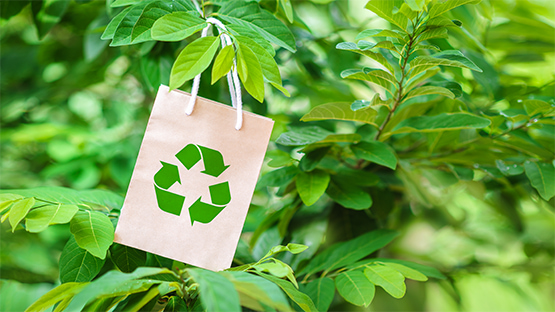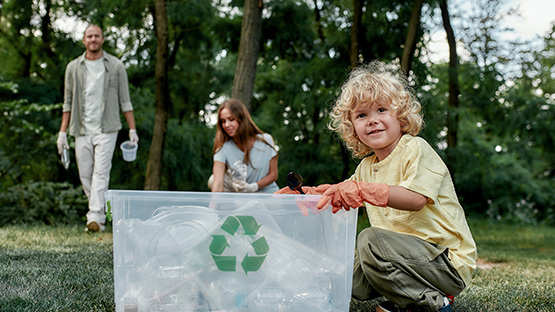Clothes recycling - how does it work and what does it involve?
Ekologia

14 January 2023
Currently, the fast fashion market is growing rapidly worldwide. This means the production of clothes that are of poor quality and are only meant to fit in with rapidly passing trends. They can be bought in many chain stores, but unfortunately a lot of them end up in landfill sites completely new. In addition, it is not uncommon for people to throw away their old or damaged clothes, all of which is bad for the environment. Clothes recycling comes to the rescue - what is it?
Clothes recycling - how does it happen?
Clothes recycling is about preventing clothes or piles of shoes from ending up in landfills. Its main idea is to turn old clothes into new ones, but not only that. Recycling also involves giving unworn items of clothing to someone else or using them for other purposes at home (e.g. as cleaning cloths).
Recycling old clothes also means repairing them and extending their life by, for example, patching or mending holes. All of this is related to the principles of circular fashion, which assumes that clothes should be in constant circulation. It is not only about managing clothes that have already been made, but also about changing the way clothes are made and the way we approach fashion.
To ensure that the world does not pile up more tonnes of discarded textiles, it is necessary to start at the very beginning, i.e. the production process. Manufacturers should pay attention to keeping fashions timeless and materials natural. This way, consumers will have less frequent need to buy a new item of clothing. It is also worth thinking about building a capsule wardrobe, i.e. a wardrobe in which you have fewer items, but they all go well together and can be used to create different styles.
Recycling is about giving a second life to clothes, so it's worthwhile not only buying from second-hand shops, but also selling off your wardrobe yourself. You could, for example, use an online clothing display app. This form of recycling can be combined with another form of recycling, i.e. using some boxes and packaging once again to send the sold clothes.
The sending of parcels of clothing can be carried out, for example, in a Paczkomat® machine. InPost also uses recycled packaging in its operations!
Why is recycling clothes so problematic?
Recycling by definition means converting one product into another. For example, recycling a plastic bottle may result in another bottle or container. When it comes to clothing, side activities such as refurbishing or selling the garment are very important, because the recycling process itself is difficult to carry out. It is particularly complicated to introduce it on a large scale. Why is this the case?
Clothes almost never consist entirely of just one material. They usually still have threads, buttons, tags, zips or linings, which are made from other raw materials. In order to be recycled, the material must not contain mixed materials. It is therefore necessary to analyse each item separately and remove items made from non-recyclable materials.
For high-quality recycled garments to be made, the process would have to be 100% single-material garments. Nevertheless, there are facilities where garments are recycled, but this has several disadvantages. The first is that such a process is very expensive and difficult to carry out. The second hassle is that a variety of fabrics are subjected to the process, however, and the product obtained after treatment is of poor quality and not much can be made of it. 
Where can clothes be recycled?
The question you may be asking yourself is where to recycle your clothes? In many towns and cities, there are containers where you can drop off your clothes for distribution to those in need. In addition, it is worth asking at various associations and centres for people in homelessness crisis, refugees or single mothers about their clothing needs. It is important to bear in mind that damaged clothing may not be donated to such places.
You can donate textiles and footwear through Eco-returns offered by InPost. Thanks to the service, unnecessary items will gain a second life.
Some shops have special bins where clothes that are no longer worn can be thrown in. The producers then recycle them or donate them to those in need. In the case of large quantities of clothes, it is also worth using companies that take the clothes and sell them to second-hands. Baby clothes are worth giving away to friends who have a younger child, for example.
Donating clothes is just one way of giving them a second life. As well as donating clothes, you can also transform old clothes into brand new items, either by yourself or with the help of a seamstress. Some people even buy second-hand clothes in second-hand shops just to sew something else out of them. Sometimes it is enough to make a small alteration, and sometimes it is even possible to create something completely new and turn, for example, trousers or a shirt into a dress.
Recycling clothes - can cotton be composted?
An interesting point about clothing recycling is that it can be composted. It turns out that 100% natural fabrics, such as cotton, can decompose. Do not compost large amounts of fabric or those that are dyed or contain admixtures of synthetic materials. In the case of pure cotton, it can be divided into smaller pieces and placed in the composter. Cotton can take about a year to decompose, which is a very short period of time compared to artificial materials.
Where to buy recycled clothing to help nature?
You already know what recycling clothes is all about, so it's time to find out where you can buy products sewn from recycled materials if you need them. Recycled clothing for children and adults can be found in an increasing number of shops. They have special tags with recycling information on them. You can also find bags, towels and a mass of other products sewn from recycled cotton, for example, on the internet.
Fortunately, more and more brands are taking action for the future of the environment, but there is still a need for every consumer to act. It's very important to look for ideas to renovate or change what's in everyone's wardrobe. Any unwanted textiles that are suitable for further use or refurbishment need to be used. Recycling clothes is indeed difficult, but with energy and willingness, it is possible to change the clothing sector of the economy to a greener one.
Czytaj również

Where to give away unwanted electronic equipment? Small items can still be useful
Electronic equipment is one of the most frequently replaced items in the home. New ones are not always bought when the old ones are no lon...

Where to donate toys you no longer need? We have a good way to do it!
Quite a few children have rooms full of toys. They receive more gadgets from grandparents, parents or aunts and uncles. Sometimes the obje...




